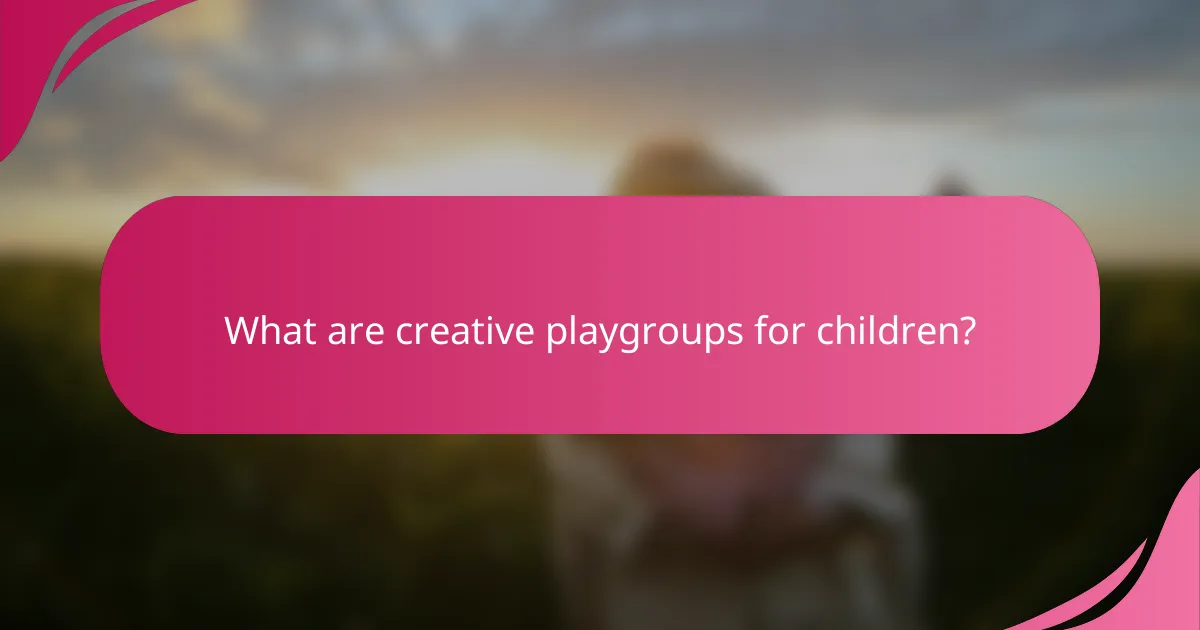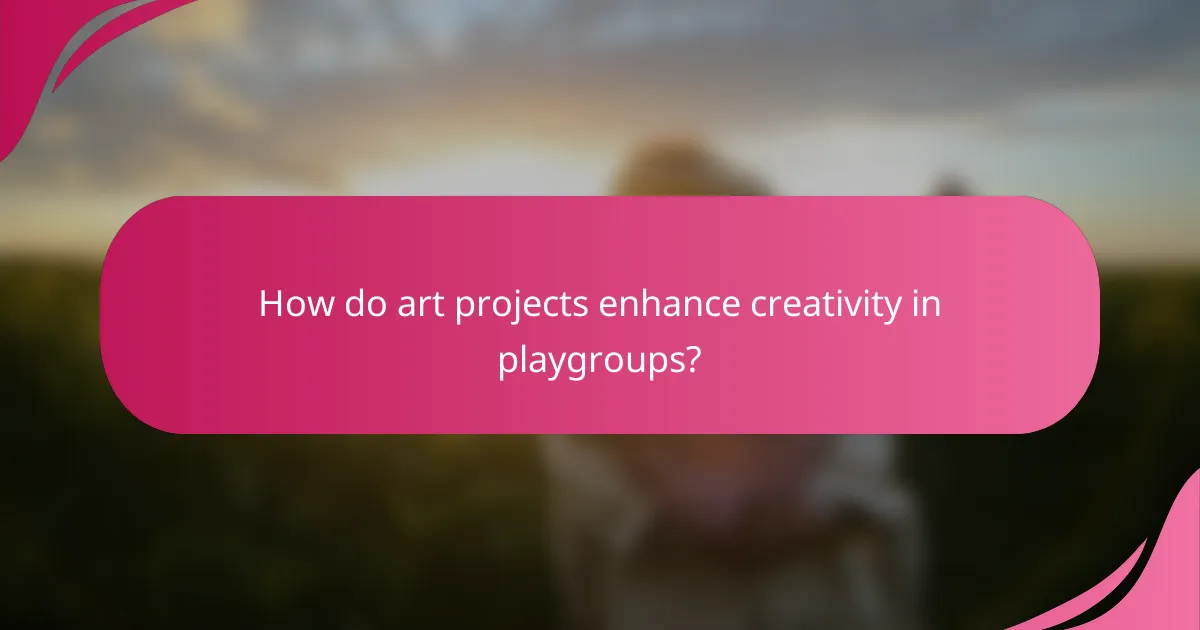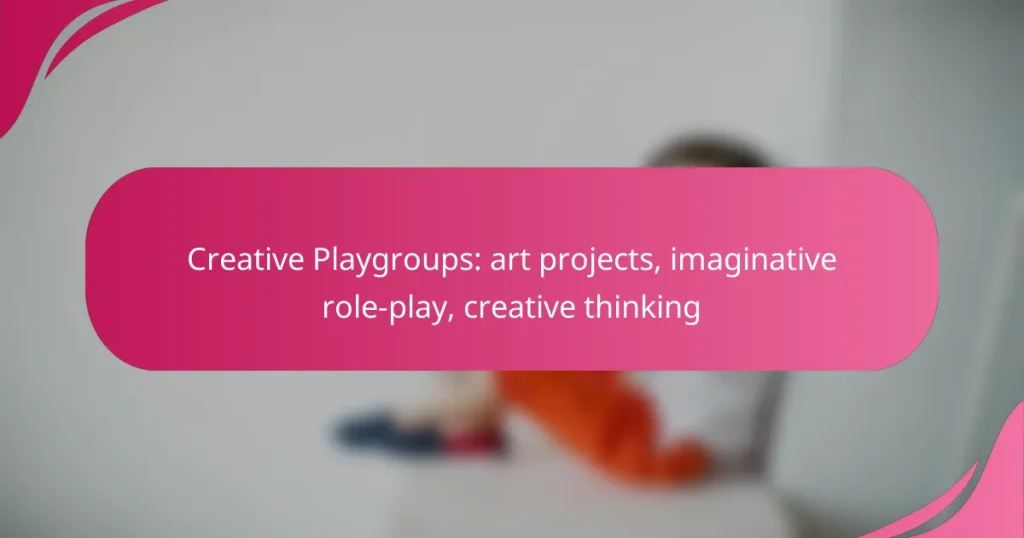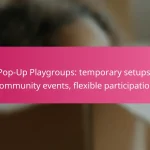Creative playgroups for children offer a dynamic environment where artistic projects and imaginative role-play come together to enhance creative thinking. These structured settings promote self-expression and collaboration, allowing kids to explore their creativity while developing essential social skills and problem-solving abilities. Through engaging art activities and interactive scenarios, children can communicate their ideas and unleash their imagination in a supportive atmosphere.

What are creative playgroups for children?
Creative playgroups for children are structured settings where kids engage in artistic projects, imaginative role-play, and activities that foster creative thinking. These groups encourage self-expression and collaboration, allowing children to explore their creativity in a supportive environment.
Structured environments for artistic expression
Structured environments in creative playgroups provide children with the tools and materials necessary for artistic expression. Common activities include painting, crafting, and building, which help children develop fine motor skills and enhance their creativity. These settings often have designated areas for different types of art, allowing children to freely explore various mediums.
To maximize engagement, playgroups typically follow a flexible schedule that balances guided activities with free play. This approach helps children feel comfortable experimenting while also learning to follow instructions and work in a group. Parents should look for playgroups that offer a variety of artistic experiences to keep children motivated and inspired.
Facilitated by educators or artists
Creative playgroups are often facilitated by educators or artists who guide children through the creative process. These facilitators provide valuable insights and techniques, helping children to refine their skills and express their ideas more effectively. Their expertise can enhance the overall experience, making it more enriching for the participants.
When selecting a playgroup, consider the qualifications and experience of the facilitators. Look for programs led by individuals with backgrounds in art education or child development, as they will be better equipped to foster a nurturing and stimulating environment. Additionally, check if the facilitators encourage collaboration among children, as this can lead to more dynamic and imaginative play experiences.

How do art projects enhance creativity in playgroups?
Art projects significantly enhance creativity in playgroups by providing children with opportunities to explore their imagination and express themselves. Engaging in creative activities fosters innovative thinking and allows children to communicate their ideas in unique ways.
Encourages self-expression through various mediums
Art projects allow children to express their thoughts and feelings using different materials such as paint, clay, and fabric. By experimenting with these mediums, children can convey their emotions and ideas visually, which is essential for their emotional development.
For instance, a simple project like finger painting can help children articulate their feelings about a particular experience. This form of self-expression not only boosts their confidence but also encourages them to share their creations with peers, fostering social interaction.
Develops fine motor skills and cognitive abilities
Engaging in art projects helps children develop fine motor skills as they manipulate various tools and materials. Activities like cutting, gluing, and painting require precision and control, which are crucial for tasks such as writing and self-care.
Additionally, these projects stimulate cognitive abilities by encouraging problem-solving and critical thinking. For example, when children decide how to combine colors or what shapes to use, they practice making choices and understanding cause-and-effect relationships. This hands-on learning approach is vital for their overall development.

What imaginative role-play activities are effective?
Effective imaginative role-play activities engage children by allowing them to explore different scenarios and characters. These activities foster creativity, enhance social skills, and improve problem-solving abilities through interactive play.
Dress-up and storytelling sessions
Dress-up and storytelling sessions encourage children to immerse themselves in various roles, enhancing their imaginative capabilities. By providing costumes and props, children can embody characters from their favorite stories or invent new ones, which promotes narrative skills and creativity.
To maximize engagement, consider setting a theme for each session, such as fairy tales or superheroes. This can help children focus their storytelling and develop richer plots. Encourage them to share their stories with peers, fostering communication and collaboration.
Interactive scenarios like market or hospital setups
Interactive scenarios, such as market or hospital setups, allow children to role-play real-world situations, enhancing their understanding of everyday life. These setups can be created using simple materials like cardboard boxes, play money, and toy medical supplies, making them accessible and easy to implement.
When organizing these activities, ensure to include various roles for children to explore, such as customers, shopkeepers, doctors, and patients. This variety helps them practice different social interactions and problem-solving skills. Regularly rotate scenarios to keep the play fresh and engaging, ensuring children remain interested and challenged.

How can parents support creative thinking at home?
Parents can foster creative thinking at home by providing an environment rich in resources and opportunities for imaginative play. Engaging children in various activities that stimulate their creativity can lead to enhanced problem-solving skills and self-expression.
Provide diverse art supplies and materials
Offering a wide range of art supplies encourages children to explore different mediums and techniques. Consider including items such as paints, crayons, clay, fabric scraps, and recycled materials. This variety allows children to experiment and express their ideas in unique ways.
When selecting materials, aim for non-toxic and safe options, especially for younger children. Look for supplies that are age-appropriate and can be used in multiple ways, such as cardboard boxes for building or natural materials like leaves and stones for collage projects.
Encourage open-ended play and exploration
Open-ended play allows children to use their imagination without predefined outcomes. Provide toys and materials that can be used in various ways, such as building blocks, dress-up clothes, or art supplies. This type of play fosters creativity and critical thinking as children navigate their own ideas.
Limit structured activities and allow for unstructured time where children can explore their interests. Set up play areas that inspire creativity, such as a designated art corner or a space for role-playing. Avoid interrupting their play too frequently, as this can stifle their creative flow.

What are the benefits of creative playgroups in urban areas?
Creative playgroups in urban areas provide children with opportunities to engage in artistic projects and imaginative role-play, enhancing their creative thinking. These groups foster a sense of community while allowing children to explore their creativity in a supportive environment.
Access to community resources and cultural events
Creative playgroups often connect children and families with local community resources, such as libraries, art studios, and cultural institutions. Participation in these groups can lead to exposure to various cultural events, including festivals, workshops, and exhibitions that enrich children’s understanding of the world around them.
For instance, a playgroup might organize a visit to a nearby museum or a local art fair, providing hands-on experiences that inspire creativity. Utilizing local resources helps children develop a sense of belonging and appreciation for their urban environment.
Fosters social skills and collaboration among peers
Engaging in creative playgroups encourages children to interact with their peers, which is essential for developing social skills. Through collaborative art projects and role-playing activities, children learn to communicate effectively, share ideas, and work together towards common goals.
For example, when children participate in a group art project, they practice negotiation and compromise, which are vital skills for future teamwork. Parents should encourage their children to express themselves while being mindful of others’ contributions, creating a balanced and inclusive atmosphere.

What criteria should parents consider when choosing a playgroup?
Parents should consider the qualifications of facilitators, the safety and accessibility of the environment, and the overall philosophy of the playgroup. These factors ensure that children engage in creative play safely while receiving guidance from knowledgeable educators.
Qualifications of facilitators and educators
When selecting a playgroup, check the qualifications of the facilitators and educators. Look for individuals with backgrounds in early childhood education, child development, or related fields, as they are better equipped to foster creative thinking and imaginative play.
Additionally, consider their experience with various art projects and role-playing activities. Experienced educators can tailor activities to suit different age groups and developmental stages, ensuring that all children benefit from the playgroup.
Safety and accessibility of the environment
The safety and accessibility of the playgroup environment are crucial for a positive experience. Ensure that the space is child-proofed, with safe materials and equipment that meet local safety standards. Check for proper supervision ratios to maintain a safe atmosphere during activities.
Accessibility is also important, especially for children with special needs. Look for playgroups that provide inclusive environments, such as wheelchair access and adaptive equipment, to ensure all children can participate fully in creative play activities.

What are some popular creative playgroup programs in the UK?
In the UK, creative playgroup programs focus on fostering artistic expression, imaginative role-play, and creative thinking among children. These programs often incorporate various activities such as art projects, storytelling, and interactive games to engage young minds.
Art Projects
Art projects in playgroups typically involve hands-on activities that allow children to explore different materials and techniques. Common projects include painting, collage-making, and sculpture using recyclable materials. These activities encourage self-expression and help develop fine motor skills.
When selecting art projects, consider the age group of the children. For younger kids, simple tasks like finger painting or using large crayons are ideal, while older children might enjoy more complex activities like pottery or mixed media art. Always ensure that materials are safe and non-toxic.
Imaginative Role-Play
Imaginative role-play is a key component of creative playgroups, allowing children to act out scenarios and explore different roles. This type of play can include dress-up, storytelling, and setting up themed environments like a shop or a kitchen. Such activities enhance social skills and boost confidence.
To facilitate role-play, provide a variety of costumes and props that reflect diverse cultures and professions. Encourage children to create their own stories or scenarios, which can lead to richer interactions and creativity. Monitor play to ensure it remains positive and inclusive.
Creative Thinking
Creative thinking activities in playgroups aim to stimulate children’s imagination and problem-solving skills. These can include open-ended questions, brainstorming sessions, and challenges that require innovative solutions. Activities like building with blocks or solving puzzles are effective in promoting creative thought.
Encourage children to think outside the box by providing them with challenges that have multiple solutions. For instance, ask them how they would build a bridge using only specific materials. This not only fosters creativity but also enhances critical thinking and collaboration among peers.


